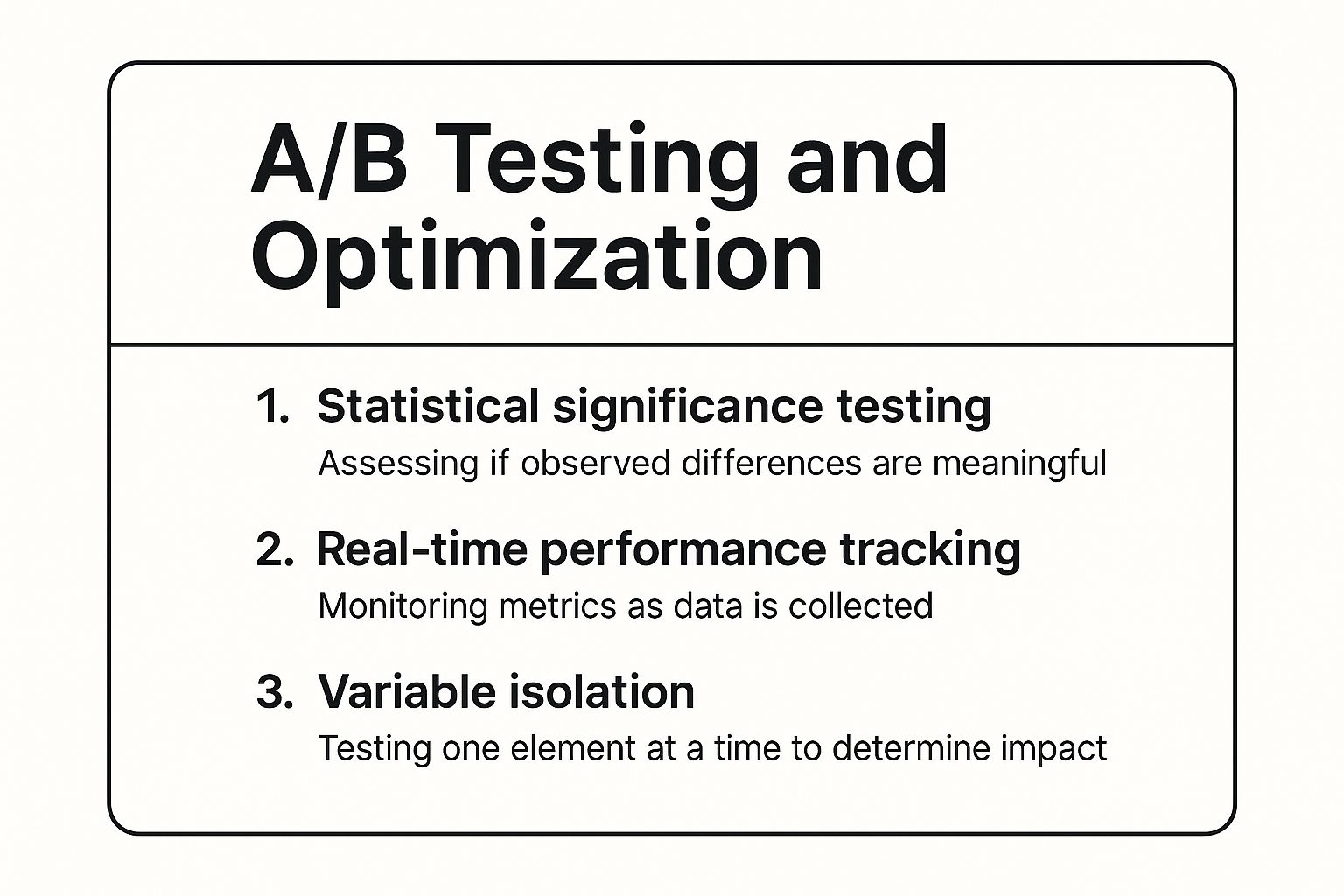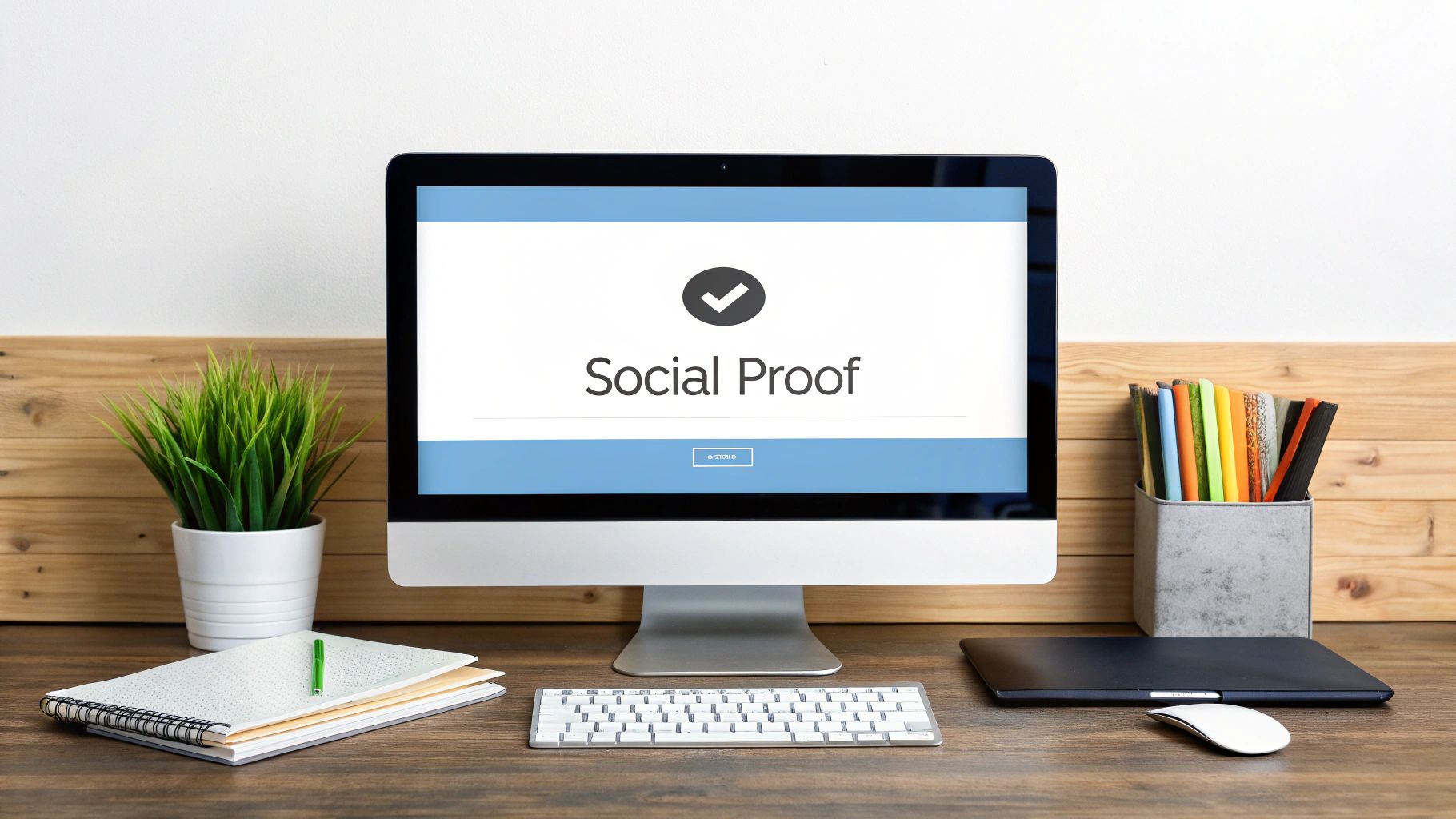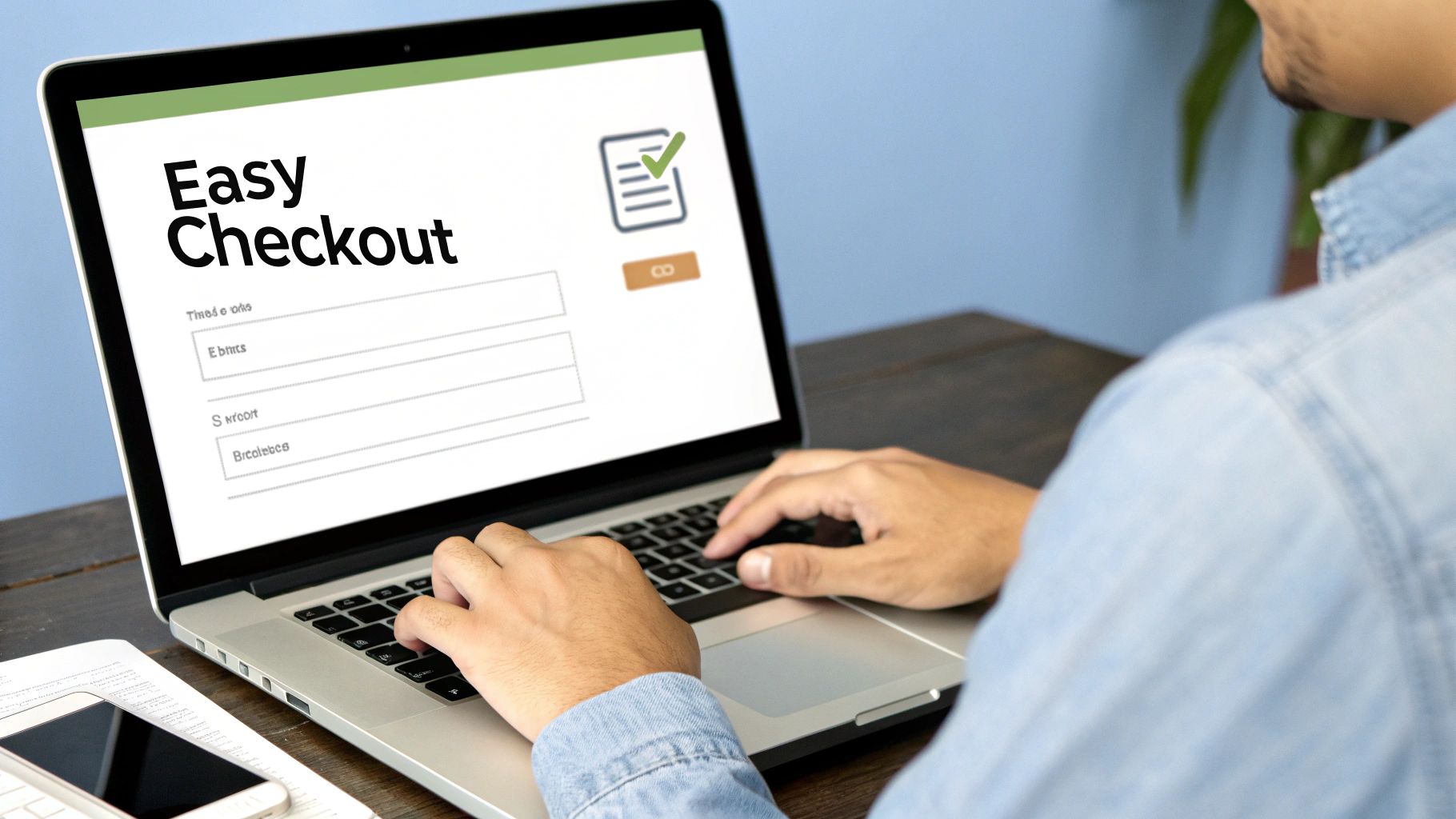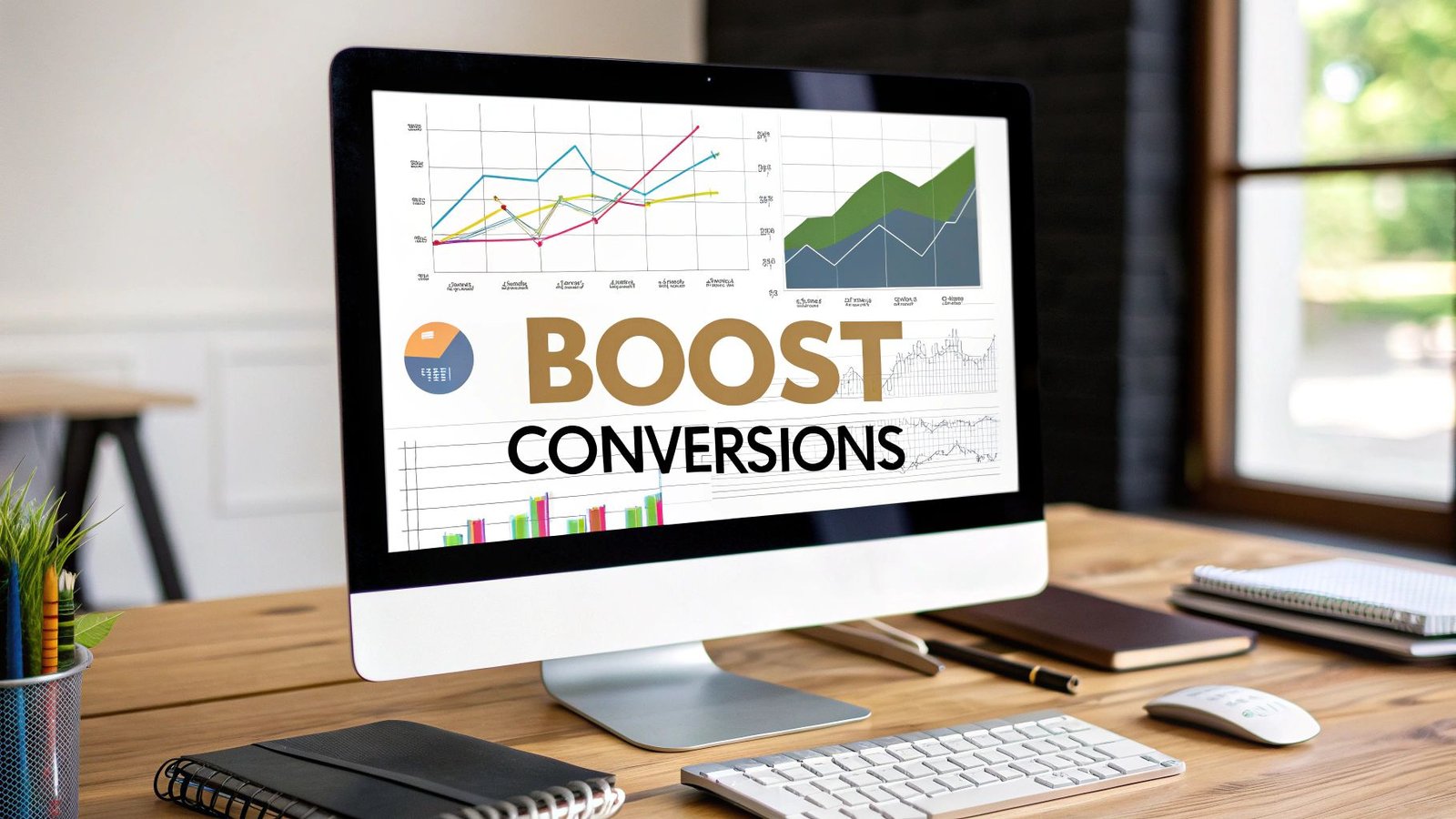In the competitive SaaS landscape, attracting website traffic is only half the battle. The real challenge, and where revenue is truly generated, lies in transforming those visitors into loyal, paying customers. This critical transition doesn't happen by chance; it requires a strategic, data-driven approach to optimization. Simply put, a higher conversion rate means more efficient marketing spend, a shorter sales cycle, and a healthier bottom line.
This article moves beyond generic advice to provide a concrete playbook. We will explore 10 specific, actionable ways to increase conversion rates, each tailored for the unique challenges SaaS teams face. You won't find vague theories here. Instead, you'll get a clear roadmap complete with practical implementation steps, real-world examples, and fresh perspectives on proven tactics.
From refining your value proposition to implementing powerful psychological triggers, these strategies are designed to enhance every touchpoint in your sales funnel. Whether you're looking to optimize your landing pages, simplify your checkout process, or re-engage hesitant prospects, the insights below will equip you with the tools needed to turn more clicks into customers. Let's dive into the proven methods that will elevate your performance and drive significant revenue growth.
1. A/B Testing and Optimization
A/B testing is a systematic approach to comparing two versions of a web page, email, or other marketing asset to determine which one performs better. By showing a control version (Version A) to one segment of your audience and a modified version (Version B) to another, you can gather empirical data on which variation drives more conversions. This data-driven methodology eliminates guesswork and is one of the most effective ways to increase conversion rates by making incremental, impactful changes.
For example, SaaS giant HubSpot famously increased sign-ups by testing different call-to-action (CTA) button colors, while Netflix constantly A/B tests its show artwork to maximize click-through rates. These small changes can yield significant results because they directly influence user behavior at critical decision points.
Implementing A/B Testing Effectively
To get started, focus on high-impact elements like headlines, CTAs, or form fields. Use tools like Optimizely or VWO to set up your tests. Remember these core principles:
- Test one element at a time to isolate the variable and understand exactly what caused the change in performance.
- Ensure a sufficient sample size to achieve statistical significance, which validates your results.
- Run tests long enough to account for fluctuations in traffic, such as running a test for a full week to cover both weekday and weekend user behavior.
This infographic summarizes the foundational principles that ensure your A/B tests produce reliable, actionable data.

By focusing on variable isolation, tracking performance, and ensuring your results are statistically sound, you can confidently implement changes that improve your bottom line. Integrating this practice deepens your understanding of user behavior at every stage. For a more comprehensive look, you can learn more about mastering sales funnel conversion rates.
2. Social Proof and Trust Signals
Social proof is a psychological phenomenon where people conform to the actions of others under the assumption that those actions reflect the correct behavior. Leveraging this principle through trust signals like testimonials, customer logos, and security badges is one of the most powerful ways to increase conversion rates. It builds immediate credibility and reassures potential customers that they are making a safe and popular choice.
For example, SaaS company Basecamp prominently displays logos of well-known clients, instantly borrowing their credibility. Similarly, Slack showcases its adoption by Fortune 500 companies, while Booking.com uses urgency-based social proof like "15 other people are looking at this hotel right now" to encourage faster decisions. These tactics reduce friction by demonstrating that others trust and value the service.

Implementing Social Proof Effectively
To get started, strategically place trust signals near critical conversion points, such as sign-up forms or pricing pages. Remember these core principles:
- Be specific and authentic by using real numbers, photos, and company names with your testimonials instead of vague claims.
- Showcase relevant proof that addresses common pain points or objections your target audience might have.
- Use a variety of signals, including customer reviews, case studies, security badges (like SSL certificates), and user counts to appeal to different visitor mindsets.
This infographic highlights key types of social proof and their impact on user trust and decision-making. By integrating authentic, relevant, and varied trust signals, you can alleviate buyer anxiety and validate the visitor's choice to convert. For a deeper understanding of building customer relationships, you can learn more about mastering customer lifecycle management.
3. Compelling Call-to-Action (CTA) Optimization
A call-to-action (CTA) is the strategic design and placement of a prompt that guides users toward a desired conversion. Optimizing your CTAs is one of the most direct ways to increase conversion rates because they act as the final signpost in the user's journey. Effective CTAs combine persuasive copy, strategic design, optimal placement, and psychological triggers to maximize the likelihood that visitors will take the next step.
For example, Unbounce discovered that changing button text from a second-person ("Get Your Template") to a first-person perspective ("Get My Template") can increase clicks by up to 90%. Similarly, Performable famously increased clicks by 21% simply by changing a button's color from green to red, demonstrating that even minor visual adjustments can significantly impact user behavior.
Implementing CTA Optimization Effectively
To start optimizing, focus on the copy, color, and placement of your most critical CTAs, such as "Request a Demo" or "Start Free Trial." Remember these core principles:
- Use action-oriented, first-person language to create a sense of ownership and urgency. Instead of "Submit," try "Get My Free Ebook."
- Create contrast and visibility by using a button color that stands out from the rest of the page's color scheme.
- Place CTAs in prominent, logical locations where users naturally look for them, such as above the fold or at the end of a compelling value proposition.
By treating your CTAs as a critical part of the conversion path, you can create powerful, persuasive prompts that drive action and directly improve your bottom line. Integrating this practice deepens your understanding of user motivation at the most crucial decision-making moments.
4. Website Speed and Performance Optimization
Website speed and performance optimization is the technical process of improving how quickly your web pages load and respond to user interactions. In today's fast-paced digital environment, even a one-second delay can lead to frustrated users and abandoned carts. Optimizing your site's speed directly impacts user satisfaction and is one of the most powerful ways to increase conversion rates by reducing bounce rates and keeping potential customers engaged.
The impact of speed on revenue is well-documented. Amazon famously calculated that every 100-millisecond delay costs them 1% in sales, while Walmart found that for every one-second improvement in page load time, conversions increased by 2%. These figures demonstrate that a fast, responsive website is not just a technical nicety but a critical business requirement for converting visitors into customers.
Implementing Performance Optimization Effectively
To get started, focus on changes that deliver the biggest performance gains. Simple backend and frontend adjustments can dramatically reduce load times. Use tools like GTmetrix or Google's PageSpeed Insights to diagnose issues. Remember these core principles:
- Compress and optimize images to reduce their file size without sacrificing quality, as large media files are a common cause of slow load times.
- Leverage browser caching to store parts of your site on a visitor's device, allowing for near-instant loading on return visits.
- Minimize HTTP requests by combining CSS and JavaScript files, which reduces the number of round trips a browser needs to make to the server.
By prioritizing a fast and seamless user experience, you remove a major barrier to conversion. A swift, responsive site not only improves your bottom line but also enhances brand perception and boosts your SEO rankings. This practice is foundational to any successful conversion rate optimization strategy. For a more detailed guide, you can learn more about the latest website optimization techniques.
5. Mobile-First Responsive Design
Mobile-first responsive design is a strategy where you design a website for the smallest screen first and then work your way up to larger screens like tablets and desktops. With a significant portion of web traffic originating from mobile devices, this approach ensures a seamless and optimized experience for the majority of users, directly impacting conversion rates by improving usability, speed, and accessibility on the go. This is a critical way to increase conversion rates in a mobile-dominated era.
For instance, Starbucks implemented a mobile-first redesign and saw a 23% increase in mobile orders, while AutoTrader's focus on mobile boosted their conversions by 25%. These results highlight how prioritizing the mobile experience caters to modern user behavior and removes friction from the conversion process, turning mobile visitors into customers.
Implementing Mobile-First Design Effectively
To get started, shift your design perspective to prioritize the constraints and advantages of a small screen. This means focusing on core functionality and content first. Remember these core principles:
- Design for touch, not clicks. Use large, easily tappable buttons and links, and ensure there is enough space between interactive elements to avoid accidental taps.
- Simplify navigation and forms by reducing the number of required fields and making the menu system intuitive for thumb-based interaction.
- Prioritize content and performance by loading only essential content, features, and scripts first, and optimizing images for fast loading on cellular networks.
By building for the smallest screen first, you ensure that all users, regardless of their device, receive a fast, intuitive, and conversion-optimized experience. This user-centric approach not only improves satisfaction but also directly supports your primary business goals.
6. Personalization and Dynamic Content
Personalization is the practice of tailoring website content, offers, and user experiences to individual visitors based on their behavior, preferences, and past interactions. Instead of a one-size-fits-all approach, dynamic content uses data to deliver relevant experiences that make users feel understood. This strategy is a powerful way to increase conversion rates because it directly addresses a user's specific needs and interests, making your solution feel like a perfect fit.
For instance, Amazon’s recommendation engine, which suggests products based on browsing history, is responsible for a significant portion of its revenue. Similarly, Netflix’s personalized content suggestions keep users engaged by showing them what they are most likely to watch next. These examples prove that a customized journey significantly boosts engagement and drives action.
Implementing Personalization Effectively
To get started, you can leverage user data to create more relevant interactions. Use marketing automation tools and customer data platforms to segment your audience and deliver dynamic experiences. Remember these core principles:
- Start with simple segmentation based on factors like industry, company size, or past behavior before moving to advanced, one-to-one personalization.
- Use browsing behavior to suggest relevant blog posts, case studies, or product features that align with the visitor's interests.
- Personalize communications by using a prospect's name, company, or recent activity in email subject lines and body content to increase open and click-through rates.
By tailoring the user journey, you create a more engaging and persuasive experience that guides prospects toward conversion. This approach is a cornerstone of modern lead nurturing. You can explore more about B2B lead nurturing strategies to deepen your understanding.
7. Simplified Checkout Process and Form Optimization
The checkout process is the final hurdle between a user's intent and a successful conversion. Streamlining this critical step by reducing friction, eliminating unnecessary fields, and optimizing forms can dramatically improve performance. This approach focuses on making the path to purchase as simple and intuitive as possible, directly addressing one of the biggest sources of cart abandonment and lead form drop-off.
A frictionless experience is one of the most effective ways to increase conversion rates because it removes last-minute hesitation. For instance, Expedia famously increased annual profits by $12 million simply by removing one optional form field, while Imaginary Landscape boosted conversions by 120% after cutting its form from 11 fields down to just four. These examples highlight how even minor sources of friction can have a major financial impact.

Implementing Form and Checkout Optimization
To begin optimizing, map out your current user journey and identify any steps or fields that are not absolutely essential. As form design expert Luke Wroblewski advocates, every field you add increases the user's cognitive load.
- Minimize required fields to only the absolute essentials needed to complete the transaction or qualify the lead.
- Implement guest checkout options to avoid forcing users to create an account, which is a major conversion killer.
- Use single-column layouts as they are easier for users to scan and complete quickly, especially on mobile devices.
- Show security badges during payment steps to build trust and reassure users that their information is safe.
- Add progress indicators for multi-step forms so users know exactly where they are in the process and how much is left.
By applying these principles, you remove barriers that cause frustration and abandonment. This focus on user experience ensures more visitors complete the final step, directly improving your bottom line.
8. Urgency and Scarcity Psychology
Leveraging urgency and scarcity is a powerful psychological tactic that taps into the human fear of missing out (FOMO) and loss aversion. By creating the perception of limited availability or a time-sensitive opportunity, you can motivate prospects to act immediately rather than delaying their decision. This strategy is one of the most effective ways to increase conversion rates because it disrupts the consideration phase and prompts a direct response.
For example, Booking.com masterfully uses this by displaying messages like “Only 1 room left at this price” or “Booked 5 times in the last 24 hours.” Similarly, Amazon’s "Lightning Deals" use prominent countdown timers to compel immediate purchases. These techniques create a compelling reason for the user to convert now instead of later.
Implementing Urgency and Scarcity Effectively
To apply this principle without alienating your audience, focus on genuine limitations and clear value. Use these core principles to guide your implementation:
- Be authentic: Use real scarcity, such as limited seats in a webinar or a genuine end-date for a promotion, to build trust. Artificial scarcity can backfire and damage your brand's credibility.
- Show specific numbers: Vague terms like "limited time" are less effective. Instead, use precise details like "Only 3 spots left" or "Offer ends in 23:15:02" to make the limitation feel more concrete.
- Combine with a strong value proposition: Urgency works best when the user already perceives high value in your offer. The scarcity should be the final push, not the primary reason to buy.
By transparently communicating time or quantity constraints, you create a powerful catalyst for action. This approach encourages decisive behavior and can significantly shorten the sales cycle, turning hesitant leads into confident customers.
9. Value Proposition Clarity and Messaging
Your value proposition is the single most important element on your key landing pages. It’s a clear, concise statement that explains how your product solves a customer’s problem, what specific benefits they can expect, and why they should choose you over a competitor. A strong value proposition immediately answers the visitor’s question, “What’s in it for me?” and is one of the most direct ways to increase conversion rates by eliminating friction and confusion.
For instance, Slack’s famous “Where work happens” instantly communicates its role as a central communication hub, while Dropbox’s “Keep life organized and work moving” clearly outlines its core benefit. These companies don’t just sell features; they sell a better, more efficient outcome, which resonates deeply with potential customers and compels them to take action.
Implementing a Clear Value Proposition
To refine your messaging, you must first understand who you're talking to and what they care about most. A powerful value proposition is both customer-centric and benefit-driven.
- Focus on benefits, not features. Instead of saying "Our software has a 256-bit encryption," say "Keep your data safe and secure with military-grade encryption."
- Use your customer’s language. Avoid industry jargon and speak in terms your audience understands. Analyze support tickets and sales calls to find the exact words they use.
- Address primary pain points directly. Your headline should promise a solution to a real problem your ideal customer faces.
- Be specific and concrete. Quantify benefits when possible, such as "Save 10 hours per week on manual data entry."
A clear value proposition is the foundation of your conversion strategy. To make it even more powerful, tailor your messaging to different audience segments. You can explore how top customer segmentation strategies for SaaS can help you craft more resonant value propositions for each group.
10. Exit-Intent Popups and Retargeting
Exit-intent popups and retargeting form a powerful two-part strategy to reclaim potentially lost customers. This approach uses technology to detect when a user is about to leave your site and presents a last-minute offer, such as a discount or free resource, to capture their information. It then uses retargeting ads to continue engaging these abandoning visitors across other websites, keeping your brand top-of-mind and guiding them back into the sales funnel.
This combination is one of the most effective ways to increase conversion rates because it addresses user indecision at a critical moment. For instance, Campaign Monitor uses exit-intent popups to offer free email templates, capturing leads who were about to leave. Similarly, MonsterInsights famously increased their email signups by a staggering 445% by implementing a well-timed exit-intent offer, proving the massive potential of this tactic.
Implementing Exit-Intent and Retargeting
To implement this strategy, use tools like OptinMonster or Privy to create your popups and platforms like Google Ads or Facebook Ads for retargeting. Focus on these key principles for maximum impact:
- Offer genuine value in your popup, like a free demo, a valuable ebook, or a special discount in exchange for an email address.
- Time your popups effectively so they appear just as the user’s cursor moves towards the exit button, not immediately upon arrival.
- Segment your retargeting audiences based on the specific pages they visited or actions they took to serve them highly relevant ads.
- Ensure popups are easy to close and optimized for mobile devices to avoid frustrating users and damaging your brand's reputation.
By combining an immediate, value-driven offer with a long-term engagement strategy, you create multiple opportunities to convert visitors who would have otherwise been lost for good. For a deeper dive into lead capture, consider exploring advanced SaaS lead generation strategies.
10 Key Methods to Boost Conversion Rates
| Strategy | Implementation Complexity 🔄 | Resource Requirements ⚡ | Expected Outcomes 📊 | Ideal Use Cases 💡 | Key Advantages ⭐ |
|---|---|---|---|---|---|
| A/B Testing and Optimization | Medium to High – needs setup and traffic | Moderate – requires traffic & tools | High – data-driven improvements & ROI | Optimization of web/email elements with measurable impact | Data-driven, scalable, reduces risk |
| Social Proof and Trust Signals | Low to Medium – content creation needed | Low – testimonials and badges | Moderate – boosts credibility and conversions | Websites needing immediate trust boosts | Builds trust quickly, cost-effective |
| Compelling CTA Optimization | Low – design and copy adjustments | Low – design and copy resources | High – direct uplift in conversion rates | Improving specific user actions (signups, purchases) | Quick impact, easy to test and implement |
| Website Speed and Performance | High – technical expertise required | High – development, hosting resources | High – improved UX, lower bounce, SEO gains | Sites with high traffic or slow load times | Enhances UX, SEO, and conversion |
| Mobile-First Responsive Design | Medium to High – requires redesign | Moderate – design and testing efforts | High – captures mobile users, better SEO | Mobile-heavy traffic sites | Future-proofs design, boosts mobile conversions |
| Personalization & Dynamic Content | High – complex data and tech setup | High – analytics, ML tools, data | High – increased engagement, loyalty | E-commerce, content platforms requiring tailored UX | Highly relevant experiences, competitive edge |
| Simplified Checkout & Form Optimization | Medium – UX design, validation setup | Moderate – development and testing | High – reduces abandonment, increases completions | E-commerce and lead generation forms | Reduces friction, quick wins in conversion |
| Urgency and Scarcity Psychology | Low to Medium – mostly content & design | Low – content creation and timing | Moderate to High – drives immediate action | Promotions, limited offers, flash sales | Creates motivation, easy to implement |
| Value Proposition Clarity & Messaging | Medium – requires research and testing | Moderate – content and design | High – reduces confusion, improves qualified leads | Early funnel landing pages and marketing messaging | Clarifies offerings, improves differentiation |
| Exit-Intent Popups & Retargeting | Medium – tech implementation and setup | Moderate – software and ad spend | Moderate to High – recovers abandoning visitors | Sites with high bounce rates needing remarketing | Recovers lost visitors, builds remarketing lists |
Start Optimizing and Watch Your Conversions Grow
The journey to higher conversion rates isn't about finding a single silver bullet. Instead, it’s about building a robust, data-driven system of continuous improvement. We've explored a powerful arsenal of strategies, each designed to remove friction, build trust, and create a more compelling user experience. From the foundational practice of A/B testing to the psychological impact of urgency and scarcity, these aren't just isolated tactics; they are interconnected components of a high-performing conversion engine.
The core takeaway is that optimization is an ongoing process, not a one-time project. Your audience evolves, market trends shift, and your product develops. Therefore, your approach to conversion must be just as dynamic. By consistently refining your value proposition, personalizing content, and ensuring a seamless mobile experience, you create a flywheel effect where each improvement builds on the last.
Your Action Plan for Higher Conversions
So, where do you begin? Don't feel overwhelmed by the need to implement all ten strategies at once. The most effective approach is to start small, measure your impact, and scale your successes.
- Identify Your Biggest Opportunity: Use analytics to find the most significant drop-off point in your funnel. Is it the landing page? The pricing page? The checkout form? Focus your initial efforts there for the highest potential return. For instance, if your forms have a high abandonment rate, start with form optimization and simplification.
- Formulate a Hypothesis: Before you change anything, define what you expect to happen. For example, "By changing our CTA from 'Sign Up' to 'Get Your Free Demo,' we expect to increase button clicks by 15% because it more clearly states the value." This frames your A/B test and makes the results more meaningful.
- Measure, Learn, and Iterate: Run your test, analyze the data, and document what you've learned, whether your hypothesis was correct or not. Every test provides valuable insight into your customer's behavior. This iterative loop is one of the most reliable ways to increase conversion rates over the long term.
Mastering these concepts transforms your approach from guesswork to a strategic, predictable method for growth. It empowers your team to make smarter decisions, build a better product experience, and ultimately drive sustainable revenue. The goal isn't just to boost a metric; it's to create an environment where your ideal customers naturally and enthusiastically say "yes." By applying these practical strategies, you are not just tweaking a website, you are building a more effective bridge between your solution and the customers who need it most.
Ready to fill your newly optimized funnel with high-quality leads? A powerful conversion strategy is most effective when you're reaching the right people. Nordic Lead Database provides access to a curated list of decision-makers, ensuring your sales team can connect with prospects who are genuinely interested in your SaaS solution. Start converting more of the right leads today by visiting Nordic Lead Database.
